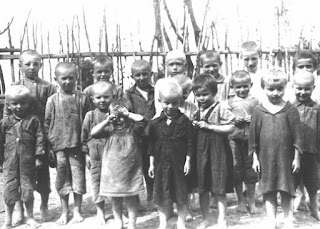Eight hundred children are gassed to death at Auschwitz
 |
| Photo of children before they were executed by the Nazis army |
Eight hundred children are gassed to death at Auschwitz
On October 10, 1944, 800 Romani children, including more than a hundred boys between 9 and 14 years old, are systematically murdered.
Auschwitz was really a group of camps, designated I, II and III. There were also 40 smaller “satellite” camps.
It was at Auschwitz II, at Birkenau, established in October 1941, that the SS created a complex, monstrously orchestrated killing ground: 300 prison barracks; four “bathhouses,” in which prisoners were gassed; corpse cellars; and cremating ovens.
Thousands of prisoners were also used as fodder for medical experiments, overseen and performed by the camp doctor, Josef Mengele (“the Angel of Death”).
A mini-revolt took place on October 7, 1944. As several hundred Jewish prisoners were being forced to carry corpses from the gas chambers to the furnace to dispose of the bodies, they blew up one of the gas chambers and set fire to another, using explosives smuggled to them from Jewish women who worked in a nearby armaments factory.
Of the roughly 450 prisoners involved in the sabotage, about 250 managed to escape the camp during the ensuing chaos.
They were all found and shot. Those co-conspirators who never made it out of the camp were also executed, as were five women from the armaments factory—but not before being tortured for detailed information on the smuggling operation. None of the women talked.
Romani people, too, had been singled out for brutal treatment by Hitler’s regime early on. Deemed “carriers of disease” and “unreliable elements who cannot be put to useful work,” they were marked for extermination along with the Jews of Europe from the earliest years of the war.
Approximately 1.5 million Romani people were murdered by the Nazis. In 1950, as Romani people attempted to gain compensation for their suffering, as were other victims of the Holocaust, the German government denied them anything, saying, they "have been persecuted under the Nazis not for any racial reason but because of an asocial and criminal record.”
They were stigmatized even in light of the atrocities committed against them.
.jpeg)


.jpg)

.jpeg)






Comments
Post a Comment